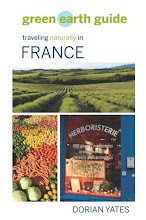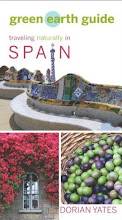


My angel Francois was the Avignon Wine Tour man who just happened on this sunny last day of January to be offering a special tour to Roussillon instead of one of his usual wine tours, and just happened to be at the Tourist Office when I was there inquiring about how I could possibly get to the ochre hills of Roussillon. Francois had one other taker for his special tour, a woman on vacation from Taiwan who spoke some English. I had noticed in every tour information flyer that the minimum number of people was two and I had thought this was just an economic decision on the tour operator’s part, but Francois explained that the laws are strict about taxis versus tour guides and you must have a taxi license to carry only one person, and have a tour guide license for two or more people.
Cameras at the ready, we set off for our tour – first stop was the village of Gordes (see pictures in this post), a beautiful, old, stone, hill village used in the shooting of the film, A Good Year. The second stop was my grail – Roussillon – site of the world’s largest ochre deposits – and the third and last stop was Menerbes, another stone hill village, famous for truffles and wine.
Gordes was pretty well shut up for the winter, but we could still see its magnificence and capture some views including the trademark blue shutters of Provence, which Francois explained repels flies and bees, but not mosquitos.
Roussillon is a photographer’s heaven, especially in the late afternoon when we were there. The deep blue of the sky juxtaposed with the red and orange buildings was magnificent. Francois let me and my tour compatriot loose with our cameras, waiting very patiently for us while we circled the village stopping every two feet to take yet another picture.
The village of Roussillon, filled with various shades of red and orange houses, sits on Mont Rouge and was the center of ochre production until World War II. At the bottom of the village there are walking paths through the ochre cliffs – le sentier des ocres – which are only open during the weekends this time of year (in high season they are open all week), but we could sneak a peek of some of the cliffs and get some pictures. Roussillon is unique in the world and this was surely a peak experience – not to be missed, and I was so glad I did not have to miss it, thanks to my angel.
Fortunately for me, and as it turns out – for Francois and my tour mate - I had done my homework for my Traveling Naturally Guide to France, so I knew there was also a Conservatory of Ochre. Francois was most agreeable and we went looking for it with the map I had from the back of a brochure. We found it about 3km down the road from the village and it was open! The first building in the complex has an extensive bookstore and is where classes are held year round in painting and special ochre applications.
Below and behind the bookstore is the L’ancienne usine Mathieu – a series of museum displays of an old ochre processing factory. We had missed the scheduled guided tour, but were free to explore on our own. Another building in the complex houses the pigment and art supply store – a painter and artist's dream land. Walls lined with jars of natural and synthetic pigments made a colorful and inspiring display. Neither Francois nor my tour mate were painters or had any knowledge about ochre other than the house exteriors we had just toured, so they admired the array of colors and delighted at this discovery.
The conservatory ships the natural powdered pigments to artists and artist supply stores around the world. I got two little bags of the natural ochre and some pastels of the same. The colors range from muted yellows to reds and browns. I confirmed with the salesperson that ochre is no longer mined at Roussillon. The sole remaining ochre mine is in a neighboring village, Gargas.
Ochre is stunning as I hope some of the pictures will illustrate. It has also been used for millennia. Some of the earliest known cave art was drawn with charcoal and ochre and the Australian Aborigines have used it in their art forever. Much of their new art is painted with synthetic ochre colors. I have read that they use the natural ochre for the work that they keep as they consider natural ochre to be sacred, which it surely is.
After our high of Roussillon, we continued to our final village stop, Menerbes. On the way we passed countless vineyards, olive and fruit groves, and some patches of grey lavender, resting until June. We drove through the village of Lacoste, known for its castle that was once owned by the Marquis de Sade and is now owned by Pierre Cardin.
Menerbes is another beautiful, stone hill town. Francois knew it well as it is a regular stop on his wine tours. Menerbes, like Gordes, was pretty well closed up for the season, but the views from the top of the village were magnificent, and we got to peek at the Maison de la Truffe et du Vin for truffle and wine connoisseurs.
The car was pretty quiet on the return drive to Avignon, each of us absorbing the wonder of the afternoon, and the joy of the experience. It was an absolutely perfect final day to a glorious ten days in Provence. I look forward to a return trip when the lavender is blooming, my other grail that I knew could not be realized in this season.
Au revoir Provence.
Conservatoire des Ocres et Pigments Appliqués: www.okhra.com
Angel Francois is available at: www.avignon-wine-tour.com. He is extremely informative, courteous, flexible and good-natured and not pushy or overbearing at all – really the perfect combination for a tour guide. If you are traveling to Avignon or any of the nearby towns I highly recommend a tour with Francois. His wine tours motto is, “You drink, I drive” – how perfect is that.













No comments:
Post a Comment